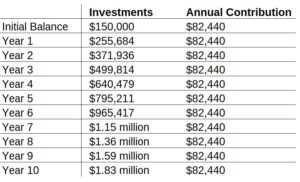Hey!
Hey you!
Are you currently at a 9-5 or 8-6 or 8-8 or (for you investment bankers, lawyers and other machines out there) 9am-1am job, making a healthy salary but thinking, GET ME OUT OF HERE!
Well, listen up. You might want to consider this exit plan millennials everywhere are embracing. It’s called FIRE.
FIRE: Financial Independence, Retire Early
FIRE is a not-so-new topic that’s currently sweeping the personal finance blog world, especially among millennials. The gist: save a lot of money while you’re young, then retire and do what you really want with your life, without worrying about making money. Like most things in life, FIRE is easier said than done.
Retirement: Same concept, different age
Planning a FIRE retirement is like planning a “regular” retirement but instead of a marathon, it’s a sprint. Unlike the 65+ years old retirement plan that provides 40+ years to save, most FIREs only give themselves 15-20 years. READY, SET, GO!
To determine how much money you need to have saved before you can retire, work backward. Answer the following:
– What age you’d like to quit the hustle
– Annual living expense for your desired retired comfort level
Once you’ve figured these out, take a look at your spending habits. Where can you cut back?
Young FIRE whipper-snappers typically aim to save 50% or more of their income. No matter which way you slice it, achieving this requires frugality. For those with higher incomes, that can mean cutting back on vacations and entertainment; for people with lower salaries, it requires finding cheap rent, cooking at home (without Blue Apron) and cutting out the daily $5 latte habit.
Not super glamorous, but it works.
There’s another school of thought in the FIRE realm called Fat FIRE, which focuses less on scrimping and frugality and more on making additional income through side-hustles, rental income and various other ways to boost income.
Regardless of method, the savings portion of FIRE requires discipline and hustle.

Investing the Goods
Saving half your income won’t get you to early retirement alone. There are two important numbers any aspiring-FIREer obsesses over: expected return on investment and expected annual withdrawal rate.
Expected return on investment (ROI): How much return your savings will make
Expected withdrawal rate: Percentage of savings you’ll need every year to pay for stuffs in retirement
Expected withdrawal rate should always remain lower than expected ROI. Aka always spend less than you make. This is a good rule for everyone, really.
Most retired people are recommended to use a 3-4% withdrawal rate. For some long but informative analysis of withdrawal rates, this Ph.D. turned blogger is right up your alley.
ROI is a bit trickier since no one can predict future investment returns perfectly. It also depends on your investment strategy. Here’s a comparison chart of annual returns from the S&P 500 vs. short and long-term U.S. gov bonds. From 2008-2017, the S&P 500 has had an average return of 10%.
A FIRE example: Fiona, the aspiring actress
Fiona works as a corporate lawyer, making $175,000 a year. She hates her job. Her dream is to be an actress. She majored in theater in college but took the LSAT and applied to law school as a backup plan. Six years later her backup plan is now her life. Whoops.
Fiona hears of this thing called FIRE and it hits her: this is her way out. She’ll retire while she’s still young (she’s currently 28) and begin her acting career. (She’s hoping Hollywood’s infuriating female age standards are a thing of the past by then.)
She’s maxed out her 401k every year and saved a good chunk of money on top of that. All said, she has about $250,000 between her retirement accounts and savings. Sad news? She still owes about $100,000 in student loans.
Fiona’s answers to our FIRE questions:
Age she’d like to quit the hustle? 38
Annual living expenses for her desired comfort level: $55,000
Expected ROI: 6%
Expected withdrawal rate: 3%
To calculate a rough estimate of Fiona’s required retirement nest egg, take the annual expenses and divide by the withdrawal rate:
$55,000 / 0.03 = $1.83 million
We’ll oversimplify here quite a bit to show a brief sketch of Fiona’s potential FIRE plan. (In reality, there are additional factors like inflation, taxes, loan repayment, etc.)
She has $250,000 saved and $100,000 in loans. Let’s assume she pays down her loans and has $150,000 to invest towards FIRE.
So, what does she need to contribute monthly to turn $150,000 into $1.83 million in 10 years? #mathtotherescue
We finagled with the numbers and concluded that if Fiona saves $112,080 a year ($9,340 a month) with a 6% ROI, she’ll reach $1.83 million in savings in 10 years. Given her $175k salary, that’s saving about 64% of her pre-tax income (assuming she never gets a raise – in which case she needs to work on her negotiating skills). Is this realistic? With some side-hustle income and serious scrimping, it could be. Constant 6% market returns are perhaps what’s less realistic, but let’s be optimists. (At least until the end of this post.)

At age 38, Fiona retires and stops her yearly retirement contributions. She relies solely on investment returns to cover her living expenses. With a 3% withdrawal rate, she’ll skim off 3% of her investment portfolio every year. Again, we’re looking at this simply, so we’re not accounting for things like penalties and taxes imposed when she withdraws from her 401k before age 55.
The World’s on FIRE
FIRE is certainly not for everyone. Some people love their jobs and see no reason to retire at age 40. Some people enjoy life a heck of a lot more when they aren’t constantly practicing mega frugality. To each her own, right?
For further reading on FIRE, there are a lot of bloggers out there covering every facet of this topic. Here are a few to check out:
If you have a favorite female FIRE blogger out there, post it in the comments! Or shout it to @she_likes_money on Twitter.



